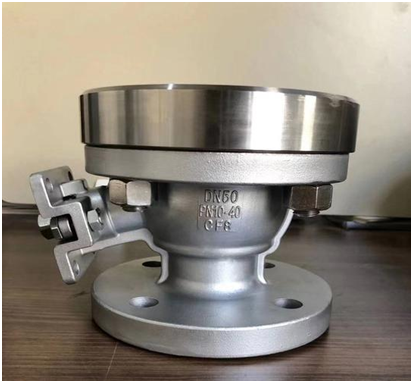Magpie Valve Selection: Accurate Matching Ensures Reliable Control
Valve Technology Sharing: Bottom-Mounted Eccentric Ball Valves Characteristics and Selection
Structural Advantages and Crystallization Challenges of 45° Inclined Installation in Reactor Bottom Applications
In industries such as chemical processing, pharmaceuticals, and petrochemical refining, bottom-mounted valves are critical for reactor discharge. Among them, bottom-mounted eccentric ball valves stand out due to their space-saving layout, addressing common issues of tight installation environments. Featuring a short-neck flange connected directly to the reactor bottom and a pneumatic actuator mounted at a 45° downward angle, these valves offer an efficient solution for limited space. However, this same design presents challenges under crystallization and sediment-prone conditions. This article explores the valve's design principles, application compatibility, and performance trade-offs, providing a technical reference for optimal valve selection.

One of the primary issues with reactor bottom valves is space limitation. Traditional top-mounted actuators often clash with reactor legs, piping supports, or other equipment, especially in systems with low reactor height or centrally located bottom outlets.
Eccentric Layout: The ball is directly connected to the reactor using a short-neck flange, reducing the radial space by approximately 50% compared to standard valves. The actuator is mounted 45° downward on the downstream side, forming an angle with the reactor base to avoid structural interference. This layout reduces vertical space requirements by over 30%, especially valuable for bottom outlets under DN200, where conventional vertical cylinders require ≥600mm clearance, while inclined setups need only 400mm.
Force Optimization: The inclined actuator generates both axial sealing force and radial opening/closing force, lowering the torque needed for operation. Measured torque decreases by 15%–20% compared to vertical setups, allowing the use of smaller actuators.
Seal Design: The valve uses a double-eccentric metal-to-metal hard seal, with both the ball and seat offset from the pipeline and rotation axes. This produces a sealing stress of 1.5–2.0 MPa, outperforming conventional ball valves (1.0–1.2 MPa), and making it suitable for medium- to high-pressure applications up to 10.0 MPa.
Material Options: The seat is hardfaced with Stellite 6, and the ball surface is nickel-phosphorus plated (50μm thickness), offering double the wear resistance of standard stainless steel. This ensures durability during frequent open-close cycles, even with slurry or particulate-laden media.
For media prone to crystallization, sedimentation, or fibrous contamination (e.g., brine, polymer slurries), this valve design introduces two major risks.
The L-shaped corner at the connection between the short-neck end and reactor bottom (Figure 2) becomes a dead zone when the valve is closed. Flow velocity drops to zero here, allowing particles to settle and form crystal layers. Upon valve opening, these layers may detach and form large crystalline chunks (10–50mm), clogging downstream piping. In one resin reactor case, blockage caused excessive pressure drop and unplanned shutdown.
Compared to top-entry ball valves (with straight-through flow paths and removable balls), bottom-mounted eccentric ball valves have less symmetric flow, reducing particle pass-through efficiency by 20%–30% (lab data: conventional ball valve passes 95% of target particles; eccentric valve passes only 75%).
During operation, crystallized particles scour and grind the sealing surfaces. The angled sliding trajectory of the ball against the seat during inclined actuation causes particles to become embedded in the micro-gaps, resulting in groove wear (0.1–0.3mm depth). Leakage rate may rise from 0.01% CV to over 1% CV, compromising the seal.
|
Feature |
Bottom-Mounted Eccentric Ball Valve |
Conventional Vertical Ball Valve |
Top-Entry Ball Valve |
|
Installation Space |
★★★★☆ (Best for tight spaces) |
★★★☆☆ (Needs vertical clearance) |
★★☆☆☆ (Needs top disassembly space) |
|
Crystallization Resistance |
★☆☆☆☆ (Prone to dead zones) |
★★☆☆☆ (Some retention) |
★★★★☆ (Straight flow path, easy clean) |
|
Sealing Performance |
★★★☆☆ (Hard seal, but prone to wear) |
★★★★☆ (Even sealing, best with clean media) |
★★★☆☆ (Depends on machining accuracy) |
|
High-Pressure Suitability |
★★★★☆ (Up to 10MPa with optimized force) |
★★☆☆☆ (Needs larger actuator) |
★☆☆☆☆ (Pressure rating limited) |
Tight reactor bottoms needing actuator clearance (e.g., lab reactors, skid-mounted systems)
Clean liquids or low-concentration suspensions (particle size <0.1mm, solids <5%) with frequent cycles
Pressurized systems ≥4.0 MPa requiring durable sealing (e.g., high-pressure polymerization reactors)
Crystallizing or sediment-prone media (e.g., evaporation vessels, wastewater tanks): opt for top-entry ball valves or knife gate valves
Large particles (>1mm) or fibrous matter (e.g., slurry): use inline filters (≤50 mesh) and quarterly cleaning maintenance
When bottom-mounted eccentric ball valves must be used under challenging media conditions, consider the following improvements:
Add internal flow guides at the short-neck inlet (15°–20° slope; Figure 3) to reduce media retention. This can cut sedimentation volume by up to 40%.
Integrate annular flushing grooves on the sealing surface to boost flow velocity to 2–3 m/s during opening, flushing away deposits.
Add pulse back-blow function: inject compressed air (0.3–0.5 MPa) into the upstream pipe for 3–5 seconds post-closure to purge residual media.
Use partial pre-opening strategy: open valve 5°–10° briefly before full opening to dislodge soft crystal layers gradually, preventing hard block release.
The 45° inclined installation of bottom-mounted eccentric ball valves is a pragmatic innovation for space-constrained environments. It solves layout issues but comes with natural limitations in handling crystallizing media. Selection should be guided by a clear trade-off analysis between spatial constraints and media compatibility:
If space is the top concern and the medium is clean, it's a smart, efficient choice.
If crystallization or blockage risk outweighs space issues, top-entry or alternative valves are better suited.
Ultimately, valve selection is never black and white, but a matter of engineering fit. Understanding each design's performance boundaries and risk zones allows for solutions that protect both process integrity and production uptime. For specific application advice, consult with engineering teams to ensure your valve design is truly tailored to your process.
